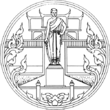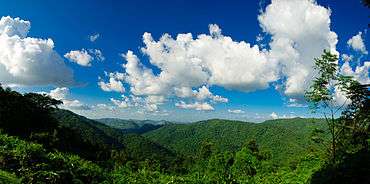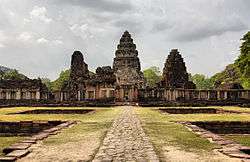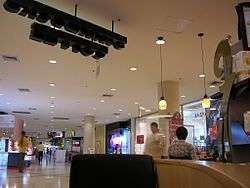Nakhon Ratchasima Province
| Nakhon Ratchasima นครราชสีมา | ||
|---|---|---|
| Province | ||
| Nakhon Ratchasima Province | ||
|
Statue of Lady Mo in Khorat city centre | ||
| ||
| Nickname(s): Khorat | ||
 Map of Thailand highlighting Nakhon Ratchasima Province | ||
| Country | Thailand | |
| Capital | Nakhon Ratchasima City | |
| Government | ||
| • Governor | Wichian Chanthranothai (since October 2015) | |
| Area | ||
| • Total | 20,494 km2 (7,913 sq mi) | |
| Area rank | Ranked 1st | |
| Population (2014) | ||
| • Total | 2,620,517[1] | |
| • Rank | Ranked 2nd | |
| • Density rank | Ranked 34th | |
| Time zone | ICT (UTC+7) | |
| ISO 3166 code | TH-30 | |
| Website | www.nakhonratchasima.go.th | |
Nakhon Ratchasima (Thai: นครราชสีมา), often called Korat (Thai: โคราช; rtgs: Khorat), is one of the Isan provinces (changwat) of Thailand's northeast corner. It is the country's largest province by area, with a population of about 2.7 million who produce about 250 billion baht in GDP, the highest in Isan.[2] Neighbouring provinces are (clockwise, from north) Chaiyaphum, Khon Kaen, Buriram, Sa Kaeo, Prachinburi, Nakhon Nayok, Saraburi, and Lopburi.
The capital of the province is the city of Nakhon Ratchasima in Mueang Nakhon Ratchasima District, also called Korat or Khorat.
Geography
The province is at the west end of the Khorat Plateau, separated from the Chao Phraya river valley by the Phetchabun and Dong Phaya Yen mountain ranges. Two national parks are in the province: Khao Yai in the west and Thap Lan in the south. Both parks are in the forested mountains of the Sankamphaeng Range, the southern prolongation of the Dong Phaya Yen mountains
Nakhon Ratchasima is a large province on the northeastern plateau and acts as a gateway to other provinces in the northeast. It is 259 kilometres (161 mi) from Bangkok and has an area of around 20,494 square kilometres (7,913 sq mi). The province is rich in Khmer culture and has a long history.
History
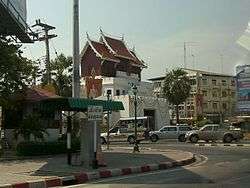
The area around Khorat was already an important centre in the times of the Khmer empire in the 11th century, as can be seen by the temple ruins in Phimai historical park. Nakhon Ratchasima Province is one of the provinces where there is still a sizable northern Khmer population.[3]
A new walled-city with a surrounding moat, designated as Nakhon Ratchasima, was built in the 17th century by order of the King Narai, as the easternmost "command post", guarding the kingdom's border. It continued this duty during the Bangkok Period, although it was briefly seized during Chao Anuwong of Vientiane's 1826 revolt against King Rama III of Siam.
Nakhon Ratchasima has long been the most important political and economic centre in the northeastern region. In the late-19th century, the railroad reached Khorat and it became the junction of two main rail lines in the northeastern, Isan, region. In 1933 it was the stronghold of the royalist troops in the Boworadej Revolt, as they fought against the new ostensibly democratic government in Bangkok. In the 1950s, the Korat Royal Thai Air Force Base was built in Nakhon Ratchasima; from 1961 until 26 February 1976, this facility was also used as a base by the United States Air Force.
Symbols
The provincial seal depicts the revered heroine of Khorat, Thao Suranari (Thai: ท้าวสุรนารี).
A monument to Thao Suranari (real name: Khun Ying Mo; 1771–1852) stands in front of the old Pratu Chumpon gate. Also called "The Great Heroine of Khorat", Kun Ying Mo was the wife of the Siamese-appointed deputy governor of Khorat during the reign of King Rama III. In 1826, Khun Ying Mo managed to repel the Laotian army led by Prince Anouvong of Vientiane who tried to reinstate control over the Khorat plateau. King Rama III conferred the title of Thao Suranari on Khun Ying Mo, as well as additional ones honouring her bravery.
The provincial tree is the sa-thorn (Millettia leucantha Kurz)
The provincial motto is "Land of brave women, fine silk material, Khorat rice noodles, Phimai Historical Park, and Dan Kwian ceramics".
Administrative divisions
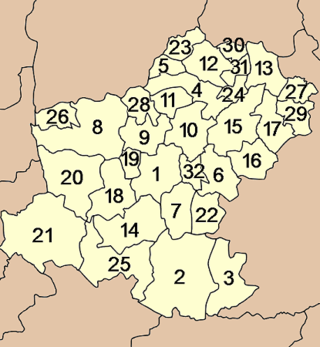

The province is divided into 32 districts (amphoe). The districts are further subdivided into 263 sub-districts (tambon) and 3,743 villages (muban).
- Mueang Nakhon Ratchasima
- Khon Buri
- Soeng Sang
- Khong
- Ban Lueam
- Chakkarat
- Chok Chai
- Dan Khun Thot
- Non Thai
- Non Sung
- Kham Sakaesaeng
- Bua Yai
- Prathai
- Pak Thong Chai
- Phimai
- Huai Thalaeng
- Chum Phuang
- Sung Noen
- Kham Thale So
- Sikhio
- Pak Chong
- Nong Bun Mak
- Kaeng Sanam Nang
- Non Daeng
- Wang Nam Khiao
- Thepharak
- Mueang Yang
- Phra Thong Kham
- Lam Thamenchai
- Bua Lai
- Sida
- Chaloem Phra Kiat
- As of 15 May 2007, the government upgraded all 81 "king amphoes" to "amphoes" to streamline administration.
| class | Name | Area (km2.) | Distance to Provincial Hall (km.) | Establish | Subdistrict (Unit) | Village (Unit) | Population. | ||
|---|---|---|---|---|---|---|---|---|---|
| Male | Female | Total | |||||||
| Special | Mueang Nakhon Ratchasima | 755.596 | 0 | 1895 | 25 | 243 | 212,627 | 221,211 | 433,838 |
| 1 | Dan Khun Thot | 1,428.14 | 84 | 1908 | 16 | 220 | 62,571 | 63,347 | 125,918 |
| 1 | Bua Yai | 305.028 | 101 | 1886 | 10 | 121 | 41,855 | 42,278 | 84,133 |
| 1 | Pak Thong Chai | 1,374.32 | 34 | 1910 | 16 | 213 | 56,716 | 58,950 | 115,666 |
| 1 | Phimai | 896.871 | 60 | 1900 | 12 | 208 | 64,421 | 66,024 | 130,445 |
| 1 | Sikhio | 1,247.07 | 45 | 1955 | 12 | 169 | 60,898 | 61,163 | 122,061 |
| 1 | Pak Chong | 1,825.17 | 85 | 1955 | 12 | 217 | 91,146 | 91,685 | 182,831 |
| 2 | Khon Buri | 1,816.85 | 58 | 1939 | 12 | 152 | 46,086 | 47,167 | 93,253 |
| 2 | Chakkarat | 501.672 | 40 | 1953 | 8 | 108 | 34,441 | 34,643 | 69,084 |
| 2 | Chok Chai | 503.917 | 30 | 1905 | 10 | 126 | 37,297 | 39,223 | 76,520 |
| 2 | Non Sung | 676.981 | 37 | 1897 | 16 | 195 | 62,639 | 65,374 | 128,013 |
| 2 | Prathai | 600.648 | 97 | 1961 | 13 | 148 | 38,622 | 38,761 | 77,282 |
| 2 | Sung Noen | 782.853 | 36 | 1901 | 11 | 125 | 38,429 | 40,181 | 78,610 |
| 2 | Huai Thalaeng | 495.175 | 65 | 1961 | 10 | 120 | 37,443 | 37,131 | 74,574 |
| 2 | Chum Phuang | 540.567 | 98 | 1959 | 9 | 130 | 40,918 | 41,038 | 82,161 |
| 3 | Soeng Sang | 1,200.24 | 88 | 1976 | 6 | 84 | 33,733 | 33,302 | 67,032 |
| 3 | Khong | 454.737 | 79 | 1938 | 10 | 155 | 40,052 | 41,076 | 81,128 |
| 3 | Non Thai | 541.994 | 28 | 1900 | 10 | 131 | 36,126 | 37,592 | 73,718 |
| 3 | Kham Sakaesaeng | 297.769 | 50 | 1968 | 7 | 72 | 21,423 | 21,753 | 43,176 |
| 3 | Kaeng Sanam Nang | 107.258 | 130 | 1986 | 5 | 56 | 18,782 | 19,054 | 37,836 |
| 3 | Wang Nam Khiao | 1,130.00 | 70 | 1992 | 5 | 83 | 20,416 | 20,503 | 40,910 |
| 4 | Ban Lueam | 218.875 | 85 | 1976 | 4 | 39 | 10,620 | 10,732 | 21,351 |
| 4 | Nong Bunmak | 590.448 | 52 | 1983 | 9 | 104 | 29,424 | 29,316 | 58,740 |
| 4 | Thepharak | 357.465 | 90 | 1995 | 4 | 58 | 12,002 | 11,451 | 23,453 |
| 4 | Phra Thong Kham | 359.522 | 45 | 1996 | 5 | 74 | 21,260 | 21,680 | 42,940 |
| 4 | Sida | 162.825 | 85 | 1997 | 5 | 50 | 12,087 | 12,133 | 24,220 |
| 4 | Bua Lai | 106.893 | 103 | 1997 | 4 | 45 | 12,374 | 12,450 | 24,824 |
| 4 | Non Daeng | 193.407 | 30 | 1989 | 5 | 65 | 12,597 | 12,984 | 25,581 |
| 4 | Kham Thale So | 203.605 | 22 | 1966 | 5 | 46 | 14,091 | 14,021 | 28,112 |
| 4 | Mueang Yang | 255.522 | 110 | 1995 | 4 | 44 | 14,321 | 14,038 | 28,359 |
| 4 | Lam Thamenchai | 308.457 | 120 | 1996 | 4 | 59 | 16,114 | 15,953 | 32,067 |
| 4 | Chaloem Phra Kiat | 254.093 | 18 | 1996 | 5 | 61 | 16,966 | 17,411 | 34,377 |
Economy
Khorat's economy has traditionally been heavily dependent on agriculture. It is known as a processing centre for Isan's production of rice, tapioca, and sugar. The Isan region accounts for half of Thailand's exports of those commodities. Khorat is also one of two sites in Thailand manufacturing disk drives by Seagate Technology, employing 12,100 workers in Khorat.[2][4]
Transport
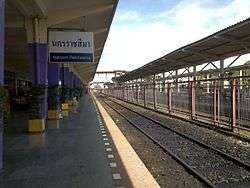
Air
Nakhon Ratchasima has one airport, but it has no scheduled flights. The nearest working airport is in Buriram and has flights to and from Bangkok.
Rail
The railway system in Nakhon Ratchasima is on both northeastern routes from Hua Lampong central terminal. Nakhon Ratchasima Province has eight main railway stations. In 2017, a 60-kilometre dual-track line will connect Khorat to Khon Kaen. It is the first segment of a dual track network that will connect Isan with the Laem Chabang seaport.[2]
Road
Highway 2 (Mittraphap Road) is the main route that connects nine districts in Nakhon Ratchasima including Muang district. This route also connects Nakhon Ratchasima to Saraburi and Khon Kaen Provinces. Hwy 24 links Si Khio District from Hwy 2 to Pak Thongcha, Chok Chai, and Nong Bunnak Districts and to Buriram Province. A new motorway connecting Khorat to Bangkok is under construction in 2016 and will reduce travel time on the 250 kilometre journey to just over two hours.[2]
Education
Universities
There are four universities in the area.
- Nakhon Ratchasima Rajabhat University
- Rajamangala University of Technology Isan
- Suranaree University of Technology
- Vongchavalitkul University
Schools
- Ratchasima Wittayalai School
- Saint Mary's College Nakhon Ratchasima
- Suranaree Witthaya
- MBAC
- Boonwatthana
- Phimai Witthaya
- Assumption School Nakhon Ratchasima
- Fort Surathamphithak School
- Phoowittaya School (lab school project)
- Plookpanya School
- Koratpittayakom school
- Wangrongnoi school
International schools
- St Stephen's International School (SIS) (Khao Yai Campus)
- Adventists International Mission School (AIMS) (Nakhon Ratchasima Campus)
- Anglo Singapore International School (Korat Campus)
- Wesley International School[5]
Facilities
Hospitals
- Maharaj Nakhon Ratchasima General Hospital
- Nakhon Ratchasima General Hospital (Khok Kruad Sub-district)
- Bangkok-Ratchasima Hospital
- Fort Suranari General Hospital
- St Mary Hospital
- Khorat Memorial
- Por-Phat Hospital
- Golden Gate Hospital
- Wing 1 Hospital
- Hua Ta Lae Hospital (Hua Ta Lae Sub-district)
Communications
- Landlines provided by TOT and TT&T
- IDD phones provided by CAT
- Mobiles provided by AIS GSM, DTAC, TRUE, and HUTCH
- Internet / High-speed internet (ADSL) provided by TOT, CAT, and TT&T.
Korat cat
(Thai: โคราช, มาเลศ, สีสวาด, rtgs: Khorat, malet, si sawat)
The Korat cat is a natural breed, and one of the oldest stable cat breeds. Originating in Nakhon Ratchasima Province at Phimai,[6] it is named after its province of origin. In Thailand the breed is known as si sawat, meaning "colour of the sawat seed" (bluish-gray). Korat cats are distinguished not only by the colour of their fur. Genuine Korat cats have a heart-shaped face when viewed from any angle and shorter grey hair with silver tips. The true breed's eyes are yellow with an inner green circle. They must be slender and agile. The cat's tail must be slender. Cats with crooked tails are considered inauspicious.[6]
In 1965, Korat cats were first registered in the US by the Korat Cat Fanciers Association. The cats that formed the breed were first imported from Thailand by Jean L. Johnson in 1959. In 1966 the breed was accepted by the Cat Fanciers Association (CFA). The Korat breed is now accepted by cat associations around the world.[6]
The International Maew Boran Association (TIMBA) ("maew boran" means "ancient cat") was formed in Thailand to provide a registry of and pedigrees for Thai cats, including Korats, and to provide a voice in English for Thai breeders as "...Thai breeders...do not speak English, and farang breeders do not speak Thai.".[7][6]
References
- ↑ "Population of the Kingdom" (PDF). Department of Provincial Affairs (DOPA) Thailand (in Thai). 2014-12-31. Retrieved 19 Mar 2015.
- 1 2 3 4 Janssen, Peter (2 November 2016). "Thailand takes a long-term gamble on Isaan region". Nikkei Asian Review. Retrieved 3 November 2016.
- ↑ Thai People In Northeastern Thailand (Isan)
- ↑ Temphairojana, Pairat (2015-02-10). "Seagate to invest $470 mln in Thailand over next 5 years". Reuters. Retrieved 3 November 2016.
- ↑ "Welcome to WIS". Wesley International School. Retrieved 7 November 2016.
- 1 2 3 4 Na Thalang, Jeerawat (6 November 2016). "Splitting hairs over cat breeds". Bangkok Post. Retrieved 8 November 2016.
- ↑ "Welcome to TIMBA". TIMBA: The International Maew Boran Association. Retrieved 10 November 2016.
External links
| Wikimedia Commons has media related to Nakhon Ratchasima Province. |
 Nakhon Ratchasima travel guide from Wikivoyage
Nakhon Ratchasima travel guide from Wikivoyage- Province page from the Tourist Authority of Thailand
- Official website
- Nakhon Ratchasima provincial map, coat of arms and postal stamp Archived January 3, 2015, at the Wayback Machine.
- Khao Yai National Park
 |
Lopburi Province | Chaiyaphum Province | Khon Kaen Province |  |
| Saraburi Province | |
Buriram Province | ||
| ||||
| | ||||
| Nakhon Nayok Province | Prachin Buri Province | Sa Kaew Province |
Coordinates: 14°58′20″N 102°6′0″E / 14.97222°N 102.10000°E
